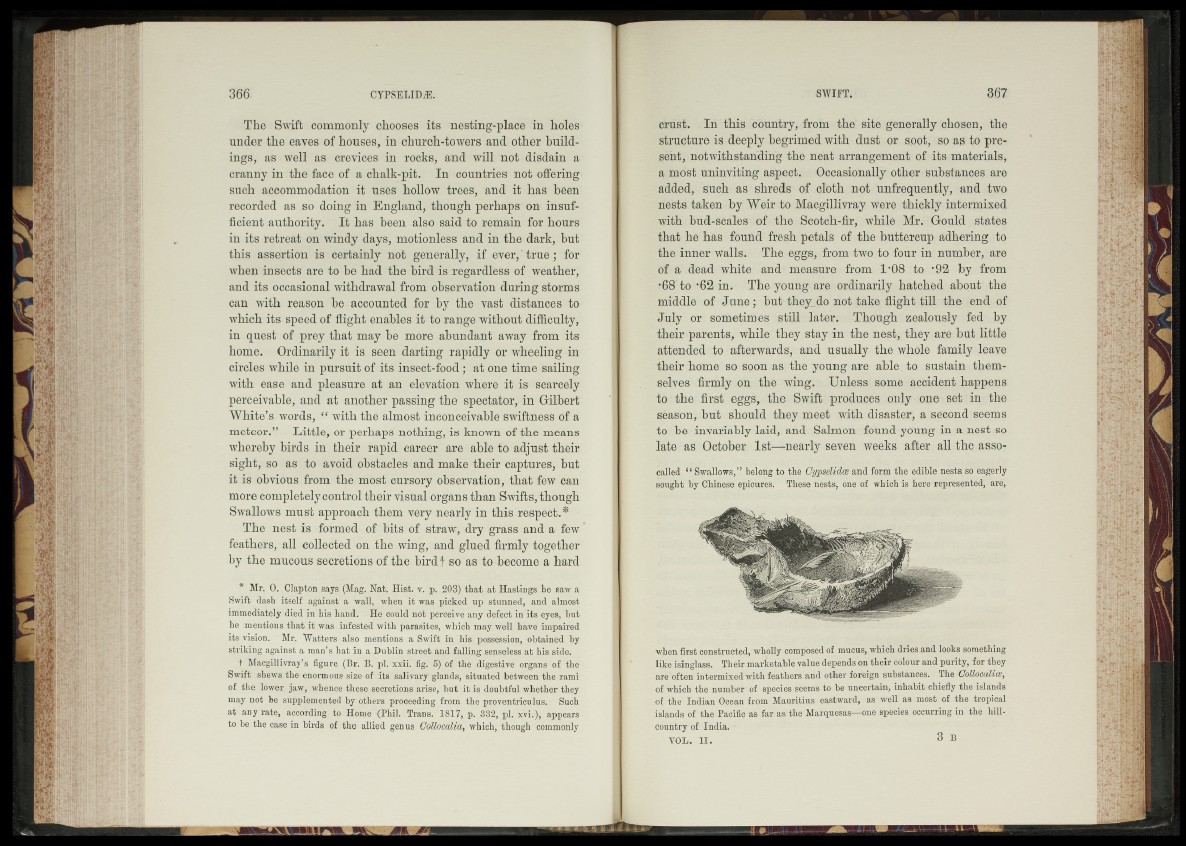
366. CYPSELIDÆ.
The Swift commonly chooses its nesting-place in holes
under the eaves of houses, in church-towers and other buildings,
as well as crevices in rocks, and will not disdain a
cranny in the face of a chalk-pit. In countries not offering
such accommodation it uses hollow trees, and it has been
recorded as so doing in England, though perhaps on insufficient
authority. It has been also said to remain for hours
in its retreat on windy days, motionless and in the dark, but
this assertion is certainly not generally, if ever,' tru e ; for
when insects are to be had the bird is regardless of weather,
and its occasional withdrawal from observation during storms
can with reason he accounted for by the vast distances to
which its speed of flight enables it to range without difficulty,
in quest of prey that may be more abundant away from its
home. Ordinarily it is seen darting rapidly or wheeling in
circles while in pursuit of its insect-food; at one time sailing
with ease and pleasure at an elevation where it is scarcely
perceivable, and at another passing the spectator, in Gilbert
White’s words, “ with the almost inconceivable swiftness of a
meteor.” Little, or perhaps nothing, is known of the means
whereby birds in their rapid career are able to adjust their
sight, so as to avoid obstacles and make their captures, but
it is obvious from the most cursory observation, that few can
more completely control their visual organs than Swifts, though
Swallows must approach them very nearly in this respect.*
The nest is formed of bits of straw, dry grass and a few
feathers, all collected on the wing, and glued firmly together
by the mucous secretions of the birdf so as to become a hard
* Mr. 0. Clapton says (Mag. Nat. Hist. v. p. 203) that at Hastings he saw a
Swift dash itself against a wall, when it was picked up stunned, and almost
immediately died in his hand. He could not perceive any defect in its eyes, but
he mentions that it was infested with parasites, which may well have impaired
its vision. Mr. Watters also mentions a Swift in his possession, obtained by
striking against a man’s hat in a Dublin street and falling senseless at his side.
t Macgillivray’s figure (Br. B. pi. xxii. fig. 5) of the digestive organs of the
Swift shews the enormous size of its salivary glands, situated between the rami
of the lower jaw, whence these secretions arise, but it is doubtful whether they
may not be supplemented by others proceeding from the proventriculus. Such
at any rate, according to Home (Phil. Trans. 1817, p. 332, pi. xvi.), appears
to be the case in birds of the allied genus Collocalia, which, though commonly
SWIFT. 367
crust. In this country, from the site generally chosen, the
structure is deeply begrimed with dust or soot, so as to present,
notwithstanding the neat arrangement of its materials,
a most uninviting aspect. Occasionally other substances are
added, such as shreds of cloth not unfrequently, and two
nests taken by Weir to Macgillivray were thickly intermixed
with bud-scales of the Scotch-fir, while Mr. Gould states
that he has found fresh petals of the buttercup adhering to
the inner Walls. The eggs, from two to four in number, are
of a dead white and measure from 1’08 to ‘92 by from
*68 to "62 in. The young are ordinarily hatched about the
middle of Ju n e; but they„do not take flight till the end of
July or sometimes still later. Though zealously fed by
their parents, while they stay in the nest, they are but little
attended to afterwards, and usually the whole family leave
their home so soon as the young are able to sustain themselves
firmly on the wing. Unless some accident happens
to the first eggs, the Swift produces only one set in the
season, but should they meet with disaster, a second seems
to be invariably laid, and Salmon found young in a nest so
late as October 1st—nearly seven weeks after all the assocalled
“ Swallows,” belong to tbe Gypselidce and form the edible nests so eagerly
sought by Chinese epicures. These nests, one of which is here represented, are,
when first constructed, wholly composed of mucus, which dries and looks something
like isinglass. Their marketable value depends on their colour and purity, for they
are often intermixed with feathers and other foreign substances. The CollocalicSf
of which the number of species seems to be uncertain, inhabit chiefiy the islands
of the Indian Ocean from Mauritius eastward, as well as most of the tropical
islands of the Pacific as far as the Marquesas—one species occurring in the hill-
country of India. •
VOL. I I. ^ B